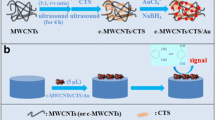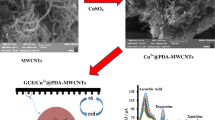Abstract
The authors report on the synthesis of a hybrid material consisting of the porphyrinoid metal complex nickel(II) norcorrole that was noncovalently bound to carbon nanotubes (CNT-NiNC). The hybrid was characterized by UV–vis, FTIR spectroscopy, and thermogravimetric analysis. The CNT-NiNC hybrid possesses high catalytic activity and selectivity toward the oxidation of ascorbic acid, dopamine, and uric acid. It was used to modify a glassy carbon electrode which then is shown to enable simultaneous or individual determination of ascorbic acid (AA), dopamine (DA), and uric acid (UA) at pH 6.5 and typical working potentials of −70, 200 and 380 mV (vs. SCE). The detection limits (at an SNR of 3) are 2.0 μM for AA, 0.1 μM for DA, and 0.4 μM for UA.

Dimesityl-substituted nickel(II) norcorrole was used to hybridize with carbon nanotubes. The hybrid possesses high electrocatalytic activity toward the oxidation of ascorbic acid, dopamine, and uric acid. The hybrid was applied to simultaneous determination of ascorbic acid, dopamine, and uric acid.






Similar content being viewed by others
References
Misra R, Chandrashekar TK (2008) Structural diversity in expanded porphyrins. Acc Chem Res 41:265–279
Wicht R, Bahnmueller S, Brandhorst K, Bröring M (2016) Cationic nickel porphyrinoids with unexpected reactivity. Chem Sci 7:583–588
Shetti VS, Prabhu UR, Ravikanth M (2010) Synthesis and studies of Thiacorroles. J Org Chem 75:4172–4182
Aviv I, Gross Z (2007) Corrole-based applications. Chem Commun 20:1987–1999
Catrinescu MM, Chan W, Mahammed A, Gross Z, Levin LA (2012) Superoxide signaling and cell death in retinal ganglion cell axotomy: effects of metallocorroles. Exp Eye Res 97:31–35
You L, Shen H, Shi L, Shang G, Li H, Wang H, Ji L (2010) Photophysical properties of the corrole photosensitizers. Sci China Phys Mech 53:1491–1496
Kruk M, Ngo TH, Savva V, Starukhin A, Dehaen W, Maes W (2012) Solvent- dependent deprotonation of meso-pyrimidinylcorroles: absorption and fluorescence studies. J Phys Chem A 116:10704–10711
Ivanova YB, Savva V, Marmardashvili NZ, Starukhin A, Ngo TH, Dehaen W, Maes W, Kruk M (2012) Corrole NH tautomers: spectral features and individual protonation. J Phys Chem A 116:10683–10694
Oort BV, Tangen E, Ghosh (2004) A electronic structure of transition metal-isocorrole complexes: a first quantum chemical study. Eur J Inorg Chem 2004:2442–2445
Kerber WD, Goldberg DP (2006) High-valent transition metal corrolazines. J Inorg Biochem 100:838–857
Bröring M, Köhler S, Kleeberg C (2008) Norcorrole: observation of the smallest porphyrin variant with a N4 core. Angew Chem Int Ed 47:5658–5660
Ito T, Hayashi Y, Shimizu S, Shin JY, Kobayashi N, Shinokubo H (2012) Gram-scale synthesis of nickel(II) norcorrole: the smallest antiaromatic porphyrinoid. Angew Chem Int Ed 51:8542–8545
Fukuoka T, Uchida K, Sung YM, Shin JY, Ishida S, Lim JM, Hiroto S, Furukawa K, Kim D, Iwamoto T, Shinokubo H (2014) Near-IR absorbing nickel(II) porphyrinoids prepared by regioselective insertion of silylenes into antiaromatic nickel(II) norcorrole. Angew Chem 126:1532–1535
Nozawa R, Yamamoto K, Shin JY, Hiroto S, Shinokubo H (2015) Regioselective nucleophilic functionalization of antiaromatic nickel(II) norcorroles. Angew Chem 127:8574–8577
Shin JY, Yamada T, Yoshikawa H, Awaga K, Shinokubo H (2014) An antiaromatic electrode-active material enabling high capacity and stable performance of rechargeable batteries. Angew Chem 126:3160–3165
Inagaki M, Kaneko K, Nishizawa T (2004) Nanocarbons-recent research in Japan. Carbon 42:1401–1417
Yang Y, Chen S, Xue Q, Biris A, Zhao W (2005) Electron transfer chemistry of octadecylamine-functionalized single-walled carbon nanotubes. Electrochim Acta 50:3061–3067
Yin Y, Lu Y, Wu P, Cai C (2005) Direct electrochemistry of redox proteins and enzymes promoted by carbon nanotubes. Sensors 5:220–234
Henning T, Salama F (1998) Carbon in the universe. Science 282:2204–2210
Rushi A, Datta K, Ghosh P, Mulchandani A, ShirsatIron MD (2013) Iron tetraphenyl porphyrin functionalized single wall carbon nanotubes for the detection of benzene. Mater Lett 96:38–41
Lu XQ, Quan YL, Xue ZH, Wu BW, Qi HT, Liu D (2011) Determination of explosives based on novel type of sensor using porphyrin functionalized carbon nanotubes. Colloids Surf B: 88:396–401
Wang ZJ, Lei HT, Cao R, Zhang MN (2015) Cobalt corrole on carbon nanotube as a synergistic catalyst for oxygen reduction reaction in acid media. Electrochim Acta 171:81–88
Liu B, Li XF, Stępień M, Chmielewski PJ (2015) Towards norcorrin: hydrogenation chemistry and the heterodimerization of nickel(II) norcorrole. Chem Eur J 21:7790–7797
Umeyama T, Mihara J, Hayashi H, Kadota N, Chukharev V, Tkachenko NV (2011) Effects of fullerene encapsulation on structure and photophysical properties of porphyrin-linked single-walled carbon nanotubes. Chem Commun 47:11781–11783
He L, Zhu YZ, Zheng JY, Ma YF, Chen YS (2010) Meso-meso linked diporphyrin functionalized single-walled carbon nanotubes. J Photochem Photobiol A Chem 216:15–23
Carla C, Campidelli S, Sooamdar C, Marcaccio M, Marcolongo G, Meneghetti M, Paolucci D, Ehli C (2007) Synthesis, characterization, and photoinduced electron transfer in functionalized single wall carbon nanohorns. J Am Chem Soc 129:3938–3945
Feng Q, Du Y, Zhang C, Zheng Z, Hu F, Wang Z, Wang C (2013) Synthesis of the multi-walled carbon nanotubes-COOH/graphene/gold nanoparticles nanocomposite for simple determination of Bilirubin in human blood serum. Sens Actuators B 185:337–344
Lewandowska K, Barszcz B, Wolak J, Graja A, Grzybowski M, Gryko DT (2013) Vibrational properties of new corroleefullerene dyad and its components. Dyes Pigments 96:249–255
Bursaa B, Wróbel D, Lewandowska K, Grajab A, Grzybowski M, Grykoc DT (2013) Spectral studies of molecular orientation in corrole-fullerene thin films. Synth Met 176:18–25
Zhao D, Fan D, Wang J (2015) Hierarchical nanoporous platinum-copper alloy for simultaneous electrochemical determination of ascorbic acid, dopamine, and uric acid. Microchim Acta 182:1345–1352
Rafati AA, Afraz A, Hajian A (2014) Simultaneous determination of ascorbic acid, dopamine, and uric acid using a carbon paste electrode modified with multiwalled carbon nanotubes, ionic liquid, and palladium nanoparticles. Microchim Acta 181:1999–2008
Sanghavi BJ, Wolfbeis OS, Hirsch T, Swami NS (2015) Nanomaterial-based electrochemical sensing of neurological drugs and neurotransmitters. Microchim Acta 182:1–41
Qi SP, Zhao B, Tang HQ (2015) Determination of ascorbic acid, dopamine, and uric acid by a novel electrochemical sensor based on pristine graphene. Electrochim Acta 161:395–402
Wang Y, Xiao Y (2012) Glassy carbon electrode modified with poly(dibromofluorescein) for the selective determination of dopamine and uric acid in the presence of ascorbic acid. Microchim Acta 178:123–130
Tu XM, Xie QJ, Jiang SY, Yao SZ (2007) Electrochemical quartz crystal impedance study on the overoxidation of polypyrrole–carbon nanotubes composite film for amperometric detection of dopamine. Biosens Bioelectron 22:2819–2826
Acknowledgments
This project was supported by National Natural Science Foundation of China (Nos. 21471052, 21375036, 21371054).
Author information
Authors and Affiliations
Corresponding authors
Ethics declarations
The author(s) declare that they have no competing interests.
Electronic supplementary material
Below is the link to the electronic supplementary material.
ESM 1
(DOC 480 kb)
Rights and permissions
About this article
Cite this article
Deng, K., Li, X. & Huang, H. A glassy carbon electrode modified with a nickel(II) norcorrole complex and carbon nanotubes for simultaneous or individual determination of ascorbic acid, dopamine, and uric acid. Microchim Acta 183, 2139–2145 (2016). https://doi.org/10.1007/s00604-016-1843-2
Received:
Accepted:
Published:
Issue Date:
DOI: https://doi.org/10.1007/s00604-016-1843-2




